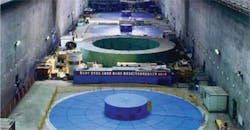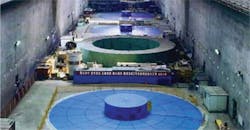Allweiler supplied 16 SMH1300 pumps to replace the original pumps in the left bank hydropower plant. Another 48 SMH1300 pumps were installed in the new right bank hydropower plant.
The Three Gorges Dam is a hydroelectric river dam that spans the Yangtze River in Sandouping, Yichang, Hubei, China. It is the largest hydroelectric power station in the world. The actual dam was completed in 2006, but the work on the hydroelectric components is still ongoing. The project has been under development since 1994 and is expected to raise the local water level to over 175 m above sea level when it is completed.
The Three Gorges project involves 32 power generator units (14 on the left bank, 12 on the right bank, and 6 underground). The project produces hydroelectricity (which produces less carbon emissions than most conventional power sources), and reduces the potential for floods downstream by providing flood storage space. After completion, the expected annual electricity generation will be over 100 TWh.
The pumps in the hydropower plant are required to operate without interruption, which means that their quality and durability are of paramount importance. In particular, the components need to be of the highest possible quality, to be able to operate safely under such stress. As well as general wear and tear, there are also several other more specific problems caused by the unique circumstances of the dam.
One of these challenges was dealing with the variations in outlet pressure. It is comparatively simple to design components to operate under steady pressure. Under the variations, however, pressure on the various components is extremely difficult to predict accurately and handle. In addition to damage to its housing, the frequent variations in pressure often lead to the damage of rotating and bearing parts of a pump.
The pumps originally employed for this application failed to meet the unique demands of this project and even broke the housings. When Colfax was brought into the project, it faced unique compatibility challenges in replacing the pumps with the existing set-up. However, knowing the precise operating conditions, Colfax was able to select the most reliable pump type to deal with it.
Allweiler SN, SM and BAS three-screw pumps were selected based on their proven safety, quality standards and local support. Specifically, 16 units of SMH1300 pumps were used to replace the original pumps in the left bank hydropower plant. Another 48 units of SMH1300 pumps were installed in the new right bank hydropower plant. This meant that a total of 64 SMH1300 pumps were installed as governor pumps in the Three Gorges Dam. In addition to these, low-pressure pumps were also installed for the lube oil system of the hydropower plant. These were 14 units of SN pumps and one BAS pump.
The pumps were used for a variety of different purposes. One of the unique applications is pumping hydraulic oil to open and close the heavy flood gates and regulate the water inlet. The SM, governor pumps (lube oil feed/boost pump) were selected due to their heavy-duty design. They are used in the hydraulic system for opening and closing the water turbine’s inlet blade. To cool the water turbine bearing, the SN lube oil circulation pump, the lube oil drain pump, and the BAS pump were used as well.
To offer the best possible service, Colfax has taken a number of different steps. A local manufacturing and service center was formed in Wuxi, China, in 2004. There are a total number of 100 workers based in this 5988m2 manufacturing and service center, which is furnished with a broad array of machining equipment, test stations, and product selection software. One of the major functions of the center is that it can provide after-sales service to customers in the region.
The center is home to a team of professionals who can provide on-site repairs, a 24 hours service hotline, and maintenance plans to our customers. It also allows for machining, assembly and testing of pumps. In order to minimize customer’s downtime, a number of spare parts are also kept at the plant. This means Colfax can meet the specific needs of our customers in the region.
In this project, we organize seminars for the design of the turbine system, and have had technical meetings with the project owners, design institutes and subcontractors on many occasions.
Moving forward, standard quality control testing procedures can be applied to ensure the quality of the pump and offer the best possible service. This standard test forms the basis of quality control. To date, there have been no problems involved with the installation or the pumps themselves.
Other services that will be offered to the clients in the future include periodical site visits, as well as periodic maintenance training for the operators of the equipment, which figures to be particularly helpful for new employees. Finally, to ensure a fast turnaround in the event of a problem, key spare parts of the pump will be kept in storage. This means that if parts need to be replaced, they can be quickly, in a structured way, with minimal delay and potential issues.



